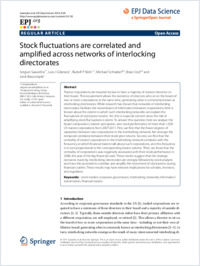Stock fluctuations are correlated and amplified across networks of interlocking directorates
- Saavedra, Serguei Integrative Ecology Group, Estación Biológica de Doñana (EBD-CSIC), Sevilla, Spain
- Gilarranz, Luis J Integrative Ecology Group, Estación Biológica de Doñana (EBD-CSIC), Sevilla, Spain
- Rohr, Rudolf P. Integrative Ecology Group, Estación Biológica de Doñana (EBD-CSIC), Sevilla, Spain - Unit of Ecology and Evolution, Department of Biology, University of Fribourg, Switzerland
- Schnabel, Michael Northwestern Institute on Complex Systems, Northwestern University, Evanston , Illinois, USA - Kellogg School of Management, Northwestern University, Evanston, Illinois, USA
- Uzzi, Brian Northwestern Institute on Complex Systems, Northwestern University, Evanston , Illinois, USA - Kellogg School of Management, Northwestern University, Evanston, Illinois, USA
- Bascompte, Jordi Integrative Ecology Group, Estación Biológica de Doñana (EBD-CSIC), Sevilla, Spain
-
22.10.2014
Published in:
- EPJ Data Science. - 2014, vol. 3, no. 1, p. 30
English
Traded corporations are required by law to have a majority of outside directors on their board. This requirement allows the existence of directors who sit on the board of two or more corporations at the same time, generating what is commonly known as interlocking directorates. While research has shown that networks of interlocking directorates facilitate the transmission of information between corporations, little is known about the extent to which such interlocking networks can explain the fluctuations of stock price returns. Yet, this is a special concern since the risk of amplifying stock fluctuations is latent. To answer this question, here we analyze the board composition, traders’ perception, and stock performance of more than 1,500 US traded corporations from 2007-2011. First, we find that the fewer degrees of separation between two corporations in the interlocking network, the stronger the temporal correlation between their stock price returns. Second, we find that the centrality of traded corporations in the interlocking network correlates with the frequency at which financial traders talk about such corporations, and this frequency is in turn proportional to the corresponding traded volume. Third, we show that the centrality of corporations was negatively associated with their stock performance in 2008, the year of the big financial crash. These results suggest that the strategic decisions made by interlocking directorates are strongly followed by stock analysts and have the potential to correlate and amplify the movement of stock prices during financial crashes. These results may have relevant implications for scholars, investors, and regulators.
- Faculty
- Faculté des sciences et de médecine
- Department
- Département de Biologie
- Language
-
- English
- Classification
- Economics
- License
-
License undefined
- Identifiers
-
- RERO DOC 258341
- DOI 10.1140/epjds/s13688-014-0030-0
- Persistent URL
- https://folia.unifr.ch/unifr/documents/304696
Statistics
Document views: 132
File downloads:
- pdf: 199
